ISSN ONLINE(2278-8875) PRINT (2320-3765)
ISSN ONLINE(2278-8875) PRINT (2320-3765)
B. Satya Sravani1, Dr.B.Prabhakar Rao2 and B.Roopa Devi3
|
| Related article at Pubmed, Scholar Google |
Visit for more related articles at International Journal of Advanced Research in Electrical, Electronics and Instrumentation Engineering
MANET is a autonomous system of mobile hosts connected by wireless links of nodes characterized by energy limited, bandwidth-constrained, decentralized administration and dynamic topology. For such scalable networks, providing consistent QoS and high performance in all scenarios is a non-trivial task. Analysis has been done to find the efficiency of a variety of protocols[1] like proactive, reactive and hybrid basing on the comparative study of different performance differentials like throughput, end-to-end delay and jitter. Simulation results of various scenarios with varying data traffic and mobility patterns using the Qualnet 6.1 network simulator is derived and ascertained the protocol which is efficient in defined metrics
Keywords |
| MANET, OLSR, AODV, ZRP, Qualnet, throughput, end-to-end delay, jitter, CBR, VBR, Random waypoint and group mobility models. |
INTRODUCTION |
| The past few years have experienced a steep growth in research in the area of wireless ad hoc networks. The attractiveness of ad hoc networks, in general, is attributed by their ability for infrastructure-less setup, minimal or no reliance on network planning and the ability of the nodes to self-organize and self-configure without the involvement of a centralized network. These features help to set up a network in situations where there is no existing network setup or in times when setting up a fixed infrastructure network is considered infeasible, for example, in times of emergency or during relief operations. |
RELATED WORK |
| A wide range of routing protocols have been proposed and implemented in various manet scenarios and ascertaining a suitable protocol according to the requirements is a non trivial issue. Continuous efforts are made in order to evaluate the routing protocols in terms of qualitative properties (distributed operation, loop freedom, demand based routing and security) and quantitative properties(end-to-end delay, throughput, route discovery time, memory byte requirement, network recovery time).Discussion of factors like mobility patterns and data traffic models and their noticeable impact on performance of protocols can be observed in [1]. |
MOBILE ADHOC NETWORK |
| A Mobile Ad Hoc Network (MANET)[5] is built on the fly where a number of wireless mobile nodes work in cooperation without the engagement of any centralized access point or any fixed infrastructure. Two nodes in such a network can communicate in a bidirectional manner if and only if the distance between them is at most the minimum of their transmission ranges. When a node wants to communicate with a node outside its transmission range, a multi hop routing strategy is used which involves some intermediate nodes. Because of the movements of nodes, there is a constant possibility of topology change in MANET. Considering this unique aspect of MANET, a number of routing protocols have been proposed so far. |
ROUTING IN MANETS |
| The issue of routing in MANET is somewhat challenging and non-trivial. Due to the mobility of the nodes, connectivity between any two nodes in the network is considered intermittent and often it is very difficult. Basically, the major challenges for routing in MANET [7] are imposed by the resource constraints and mobility of the nodes participating in the network. As there is no fixed infrastructure in such a network, we consider each node as a host and a router at the same time. Hence, during routing of data packets within the network, at each hop, each host also perform the tasks of a router. |
CLASSIFICATION OF ROUTING PROTOCOLS IN MANETS |
| Different deployment scenarios and application-dependent requirements need the employment of different types of routing mechanisms [6].Though there is no common consensus about the method of keeping the information about routes in the network, many routing protocols have been proposed on the basis of all the available methods. The routing protocols for MANET could be broadly classified into two major categories: |
| - Proactive Routing Protocols |
| - Reactive Routing Protocols |
| - Hybrid Routing Protocols |
| PROACTIVE ROUTING PROTCOLS: Proactive protocols continuously learn the topology of the network by exchanging topological information among the network nodes. Thus, when there is a need for a route to a destination, such route information is available immediately. The main concern regarding using a proactive routing protocol is that if network topology changes too frequently, the cost of maintaining the network might be very high. Moreover, if the network activity is low, the information about the actual topology might even not be used and, in such a case, the investment with such limited transmission ranges and energies is lost, which might result in a shorter lifetime of the network than that is expected. Proactive protocols are sometimes called as table-driven routing protocols. Optimized Link State Routing (OLSR) is a proactive protocol inherits the stability of link state algorithm. Usually, in a pure link state protocol, all the links with neighbour nodes are declared and are flooded in the entire network. But, OLSR is an optimized version of a pure link state protocol designed for MANET. This protocol performs hop-by-hop routing; that is, each node in the network uses its most recent information to route a packet. Hence, even when a node is moving, its packets can be successfully delivered to it, if its speed is such that its movements could at least be followed in its neighbourhood. The optimization in the routing is done mainly in two ways. |
| Firstly, OLSR [4] reduces the size of the control packets for a particular node by declaring only a subset of links with the node’s neighbours who are its multipoint relay selectors, instead of all links in the network. Secondly, it minimizes flooding of the control traffic by using only the selected nodes, called multipoint relays to disseminate information in the network. As only multipoint relays of a node can retransmit its broadcast messages, this protocol significantly reduces the number of retransmissions in a flooding or broadcast procedure. |
| REACTIVE ROUTING PROTOCOLS: The reactive routing protocols, on the other hand, are based on some sort of query-reply dialog. Reactive protocols proceed for establishing routes to the destination only when the need arises or on demand basis. They do not need periodic transmission of topological information of the network; hence, they primarily seem to be resource-conserving protocols. Reactive protocols are also known as on-demand routing protocols. |
| Ad Hoc On-Demand Distance Vector Routing (AODV) [2] is basically a reactive protocol. It minimizes the number of broadcasts by creating routes based on demand. When any source node wants to send a packet to a destination, it broadcasts a route request (RREQ) packet. The neighbouring nodes in turn broadcast the packet to their neighbours and the process continues until the packet reaches the destination. During the process of forwarding the route request, intermediate nodes record the address of the neighbour from which the first copy of the broadcast packet is received. This record is stored in their route tables, which helps for establishing a reverse path. |
| If additional copies of the same RREQ are later received, these packets are discarded. The reply is sent using the reverse path. For route maintenance, when a source node moves, it can re-initiate a route discovery process. If any intermediate node moves within a particular route, the neighbour of the drifted node can detect the link failure and sends a link failure notification to its upstream neighbour. This process continues until the failure notification reaches the source node. Based on the received information, the source might decide to re-initiate the route discovery phase. |
| HYBRID ROUTING PROTOCOLS: Often reactive or proactive feature of a particular routing protocol might not be enough; instead a mixture might yield better solution. Hence, in the recent days, several hybrid protocols are also proposed. The hybrid protocols include some of the characteristics of proactive protocols and some of the characteristics of reactive protocols. |
| Zone Routing Protocol (ZRP) is a hybrid protocol that reduces the control overhead of proactive routing protocols and decrease the latency caused by routing discover in reactive routing protocols. ZRP defines a zone around each node consisting of its k neighbourhood. That is in ZRP all nodes within k-hop distance from node belong to the routing zone of node. ZRP is formed by two sub protocols, a proactive routing protocol i.e. Intra-zone routing (IARP)[8], is used inside routing zones, and a reactive routing protocol i.e. Inter-zone routing protocol(IERP)[9], is used between routing zones, respectively. A route to a destination within the local zone can be established from the proactively cached routing table of the source by IARP. Therefore if the source and destination is in the same zone the packet can be delivered immediately. For routes beyond the local zone, route discovery happens reactively. The source node sends a route requests to its border nodes, containing its own address, the destination address and a unique sequence number. Border nodes are nodes which are exactly the maximum number of hops to defined local zone away from the source. The border nodes check their local zone for the destination. If the requested node is not a member of this local zone, the node adds its own address to the route request packet and forwards the packets to its border nodes. If the destination is a member of the local zone of the node it sends a route reply on the reverse path back to the source. The source node uses the path saved in the route reply packet to send data packets to the destination. |
SIMULATION ENVIRONMENT |
| Simulations are carried out using Qualnet 6.1[3] |
| DATA TRAFFIC MODEL: A traffic generation model is a stochastic model of the traffic flows or the data sources in a communication network. We have used two different data traffic [1] VBR and CBR. CONSTANT BIT RATE: CBR is the form of a technique which is used for the purpose of measuring the rate at which the encoding of the data takes place. It is not an ON/OFF traffic. |
| VARIABLE BIT RATE: VBR is an ON/OFF traffic with exponential distribution. It generates traffic during ON period. Vbr files vary the amount of output data per time segment. VBR allows a higher bid rate (and therefore requires more storage space) to be allocated to the more. |
| MOBILITY MODEL: The mobility model defines node movement pattern in Wireless Ad-hoc network. These models can have a great effect upon the result of simulation and thus the evaluation of these protocols. There are two types of mobility models. Entity or Individual mobility model and Group mobility model. Random waypoint and Group Mobility model are used in our work. |
| RWP (RANDOM WAYPOINT) MOBILITY MODEL: It is very simple model based on pause time between changing direction or speed. In this model each node is assigned an initial location, a destination and a speed. A mobile node begins by staying in one location for a certain period of time (i.e. pause). Once this time expires, the mobile node chooses a random destination in simulation area and a speed that is uniformly distributed between maximum speed and minimum speed. The mobile node then travel toward the newly chosen destination at the selected speed. Upon arrival, the mobile node pauses for a specified period of time starting the process again. |
| GROUP MOBILITY MODEL: In group mobility model nodes move independent of one another. The Group mobility model represents the random motion of a group of mobile nodes as well as the random motion of each individual mobile node within the group. Group movements are based upon the path travelled by a logical centre for the group. It is used to calculate group motion via a group motion vector. The motion of the group centre completely characterizes the movement of this corresponding group of mobile nodes including their direction and speed. Individual mobile nodes move about their own predefined reference points whose movements depend on the group movement. |
PERFORMANCE METRICS |
| THROUGHPUT: Throughput is total packets successfully delivered to individual destination over total time divided by total time. The throughput is analyzed with varying CBR and VBR data traffic. |
| END-TO-END DELAY: The delay of the packet is the time it takes the packet to achieve the destination after it leaves the source. |
| AVERAGE JITTER: Jitter is the time variation between packets arriving caused by network congestion, timing drift or route changes. Jitter should be small for a routing protocol to perform better. |
| SIMULATION SETUP |
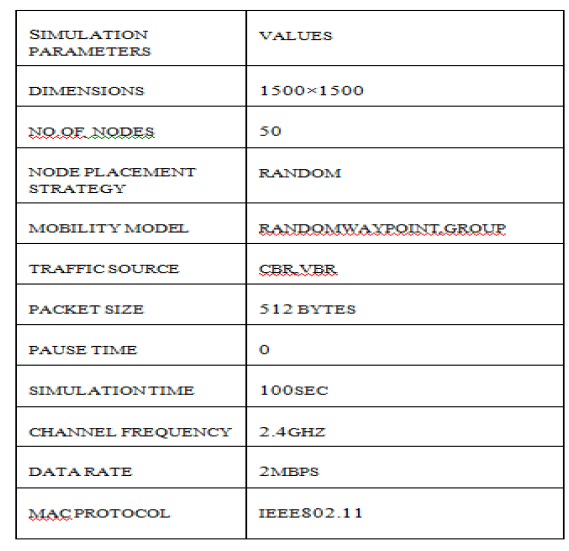 |
SIMULATION RESULTS |
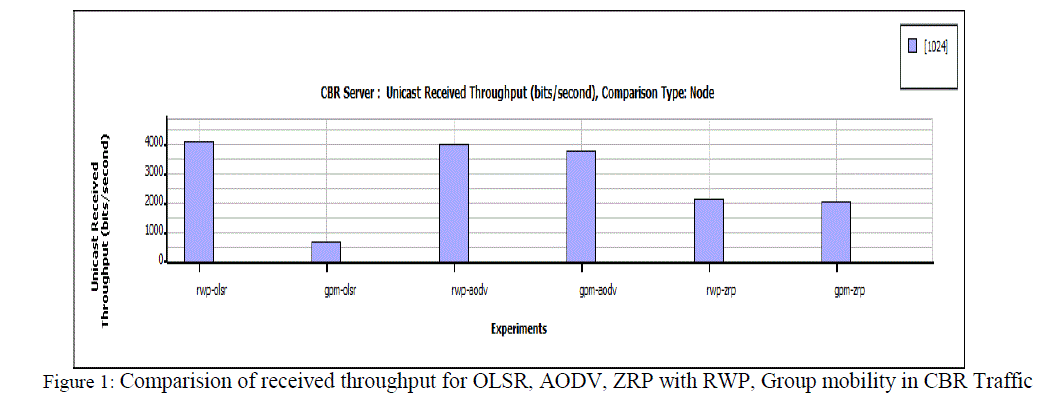 |
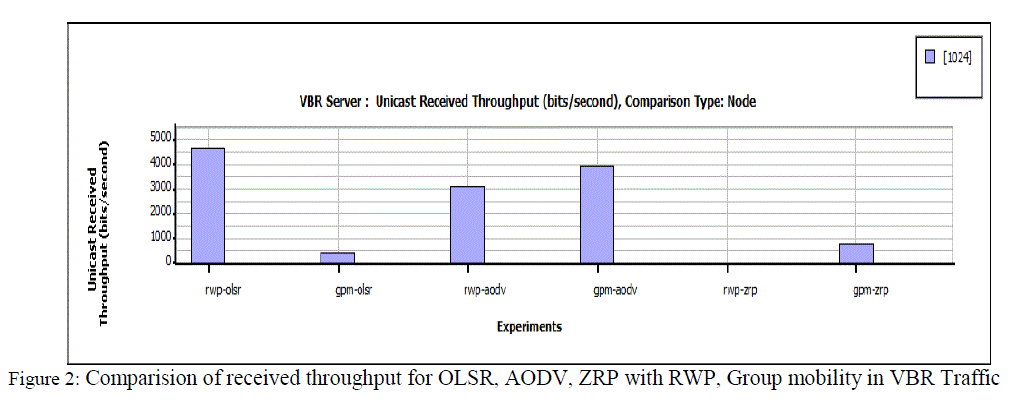 |
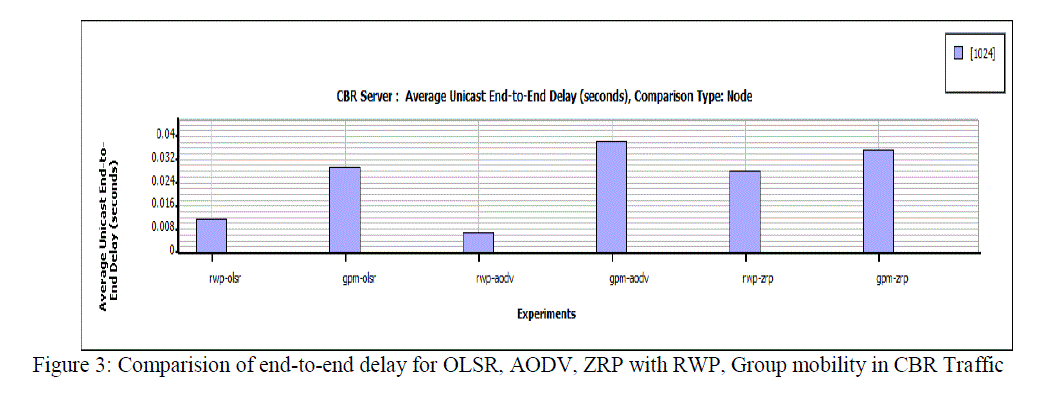 |
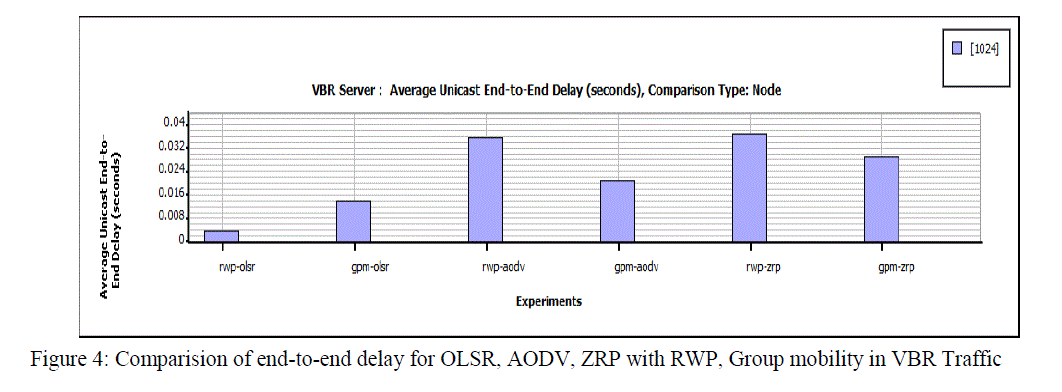 |
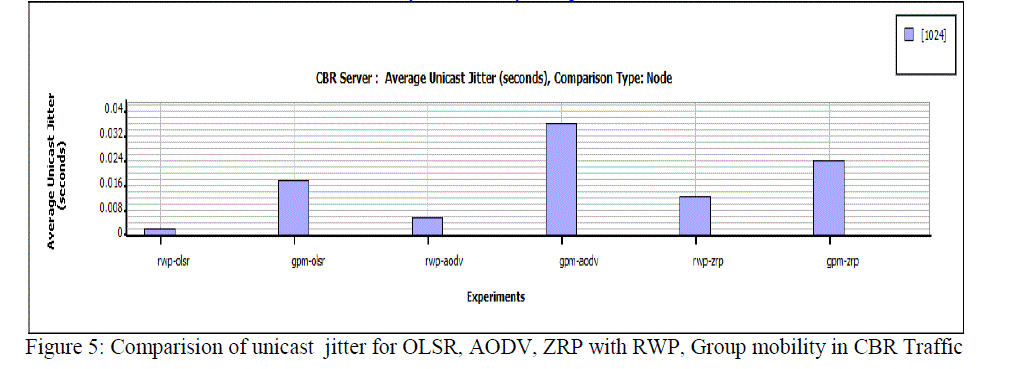 |
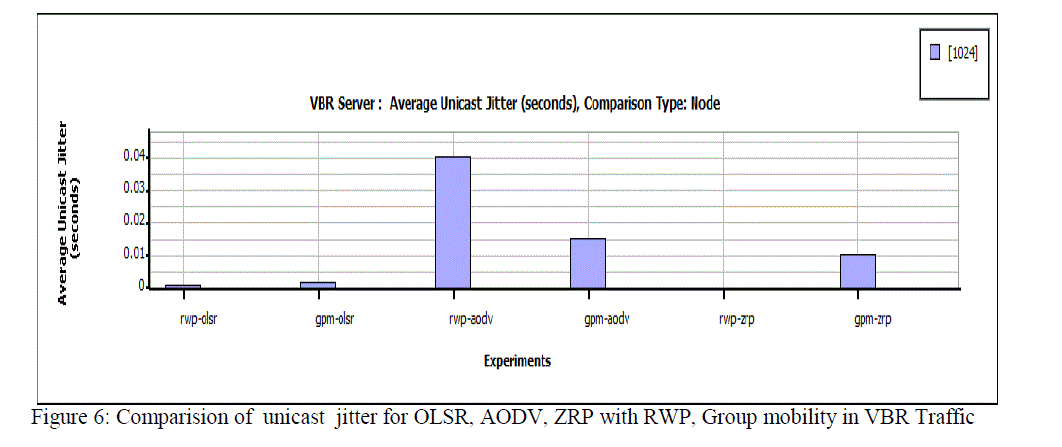 |
RESULTS DISCUSSION |
| From the simulation results of fig 1 and 2, we can analyse that OLSR with random way point mobility of nodes is efficiently delivering data packets in both traffic models since it relies on periodic broadcasts of neighbourhood information. However, with group mobility, performance of AODV is better to OLSR in both traffic models.ZRP is delivering low performance in both scenarios. |
| From the simulation results of fig 3 and 4, we can observe that OLSR is having smaller delays when compared to others because it has reduced routing overhead and queuing delay. Whereas AODV, ZRP are consistently having more delays because of their on-demand basis route discovery and maintenance. From the simulation results of fig 5 and 6, we can understand that OLSR is having less jitter in both scenarios since the time difference between the packets receival is more constant when compared to AODV and ZRP where there exist more chances for traffic congestion and latency. |
CONCLUSIONS |
| In this paper, the performance of three prominent routing protocols using the network simulator –Qualnet 6.1 has been analysed. The study reveals that OLSR outperforms AODV and ZRP in most of the scenarios. Throughput of OLSR is high in both traffic models since it is basically a table driven protocol which continuously keeps track of neighbourhood information. Performance of AODV is also nearer to OLSR, especially good in case of group mobility model. End-to-end delays are also comparatively low in OLSR because of its consistent route discovery, route maintenance and recovery while delays are high for AODV and ZRP. Jitter is also very low for OLSR in comparision with AODV and ZRP since it relies on multipoint relays, hello and control messages. But the chances of network congestion, latency in delivery of packets is high in case of AODV and ZRP which depends on-demand route discovery and no reuse of routing information. |
References |
|